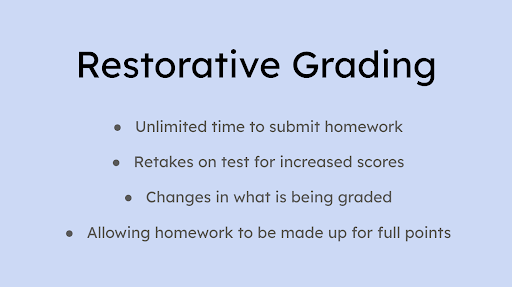Restorative grading provides students relief
What if you completely failed a math test, but in a week felt like you knew the material much more? Does an F truly reflect your understanding of a subject weeks or months after a test? Although students have had over a year to rebalance themselves after COVID-19 and online schooling, academic challenges caused by the pandemic remain. More than this, simple issues of student life will always be challenging and restorative grading helps provide some relief.
Restorative grading is the idea that students should have more opportunities to increase their grades on tests and assignments to reflect their true understanding of the material. A major point of this system is that scoring on tests would have a minimum of 50 percent, meaning students who score lower than this threshold would be compensated to meet it. Another key part is that students who miss assignments or score poorly on them would have time to not only redo or make them up, but be able to complete them for full credit.
At CVHS, a system relative to restorative grading has been introduced for the last few years is standards-based grading. Similarly, standards-based grading allows students the option to retake tests, often up to 100 percent, and provides them the choice to make up assignments, like homework. One major difference is that CVHS’s system does not include a minimum score students can achieve on tests. This system gives students a fair amount of opportunities compared to previous systems, in which students who forget homework or do poorly on exams now have a chance to reflect progress in learning and improve their grades.
“[It] allows for students to not be as harshly punished for missing work whilst still comprehending material. It allows for the students to be less jaded and prevents them from falling down the spiral of missing assignments,” said senior Ariyan Jazaeri. Jazaeri explains how the restorative grading policies help reduce students’ fear or anxiety over a building load of missing assignments, especially because they can receive full credit on them.
“I think aspects of restorative grading are good. For example, giving students opportunities to reassess standards, skills, and concepts. We should not punish students if they do not understand or know something at the moment,” explained statistics teacher Victor Wu. Students’ understanding of material changes over time, and providing opportunities to show that should be both allowed and encouraged. Wu continued: “Personally, I also think that we need to change our perspectives on grades in general. For example, a C is commonly viewed as a pass, but there is a very negative connotation behind it, as barely passing, when in reality, a C is supposed to be the average of scores.”
Although restorative grading has helped provide students with greater help in school, there is still work to be done regarding how parents, teachers, and students alike view grades.
“I think it allows some students to get away without doing their work, while others who do their work are not as rewarded,” stated sophomore Yusef Scott.
Although many believe the system to be beneficial to students, some view it as a free ticket to not doing homework or slacking off. The system, which allows students to retake tests and make up homework after a great deal of time, means that students who consistently do work and score highly on tests are not as competitively awarded. Moreover, scoring well the first time around does not mean as much when you can retake as many times as necessary.
As for whether or not the system truly helps students, a recent poll on CVHS students’ grades show that there are more B’s and C’s and fewer A’s and F’s than two years ago. This data explains that the new grading system has put most students in the middle ground in terms of letter grades. Moreover, it shows how the grading system has not impacted every student’s scores, but depends on each person. In other words, if a student is simply a bad test taker, standard-based grading could lower their grades, whereas if someone does well on a test but does not turn in homework, their grades could improve.
Between students and teachers who view it differently, restorative grading is more than likely here to stay. Despite giving students less of an advantage who turn their assignments in on time and score well on tests, the system allows everyone more opportunities to increase their grades and show how their learning of material has improved. As for whether or not tests will eventually have a minimum score for students, we will have to wait for changes to come to our standard-based grading.


Restorative grading and standards-based grading are 2 VERY DIFFERENT THINGS that are NOT similar.
Standards-based grading is by NO MEANS helpful, and is CERTAINLY NOT restorative, in fact, it is a rubbish grading system that is the opposite of restorative.
On the other hand, there is restorative grading. I think that retakes and redos are helpful, and being able to do that for full credit is something that I think should be able to be done. It can certainly be done without standards-based grading at all, and that is PROVEN to be true.